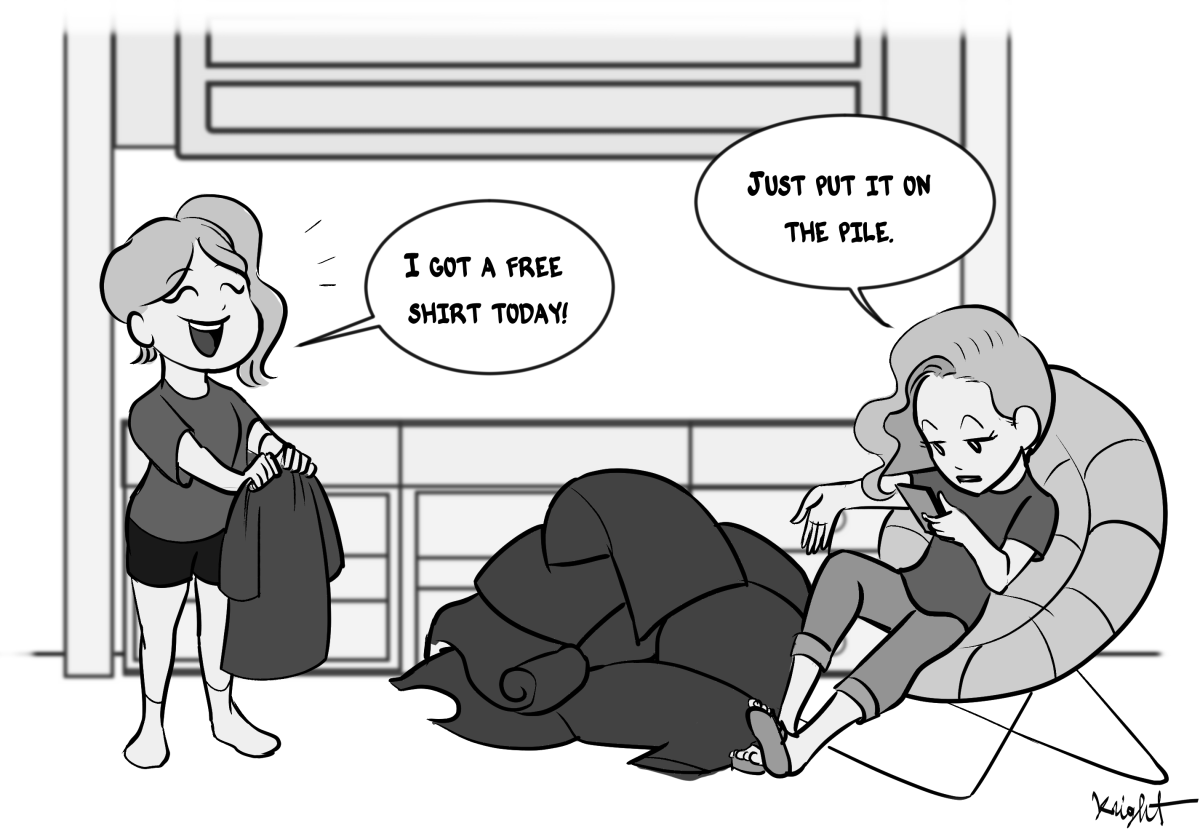
Pearl Knight, Staff Cartoonist
Free Shirt Fiasco
With the sheer amount of new free T-shirts that pop up at NC State every year, you would think part of the endowment was invested in screen printing. Just as a disclaimer, this article is not against anyone who wears a shirt they got for free every now and again. My problem is with all of the event organizers and leaders who go through the logistics of an event and think “T-shirts, we need T-shirts.” Everyone already has more shirts than they can ever wear, and each new shirt comes with both a fiscal and environmental cost.
Each stage of life brings on a barrage of new T-shirts. You need a shirt for every club you were in, every event you volunteered for, 5K you ran or candidate you voted for. This problem is exacerbated in college, where there are large events every week and hundreds of clubs. Not to mention the worst offenders, sororities and fraternities, who seem to make a new set of Panhellenic shirts every month.
It may be cliche, but nothing is free. Most of the shirts you can get for free on campus will come out of one of the student fees you pay with tuition or from club dues. It’s important to think about what else that money could go towards that is more valuable than a shirt. But when T-shirts are offered, of course, people take them because they’re free, and who doesn’t like T-shirts?
Your overstuffed pajama drawer doesn’t like T-shirts. The reality is, one person can only wear so many shirts, or will even want to. The majority of shirts are worn the day of the event and maybe a few other times in the outside world, and then they are relegated to the pajama drawer because there is some sentimental value attached to it, so you can’t just get rid of it. By then you’ve probably gotten a new T-shirt anyway. A few years go by until your pajama drawer is filled and you decide to donate it.
Your local thrift store doesn’t like T-shirts either. As a frequent Goodwill shopper, I can’t tell you how many “Class of 2015 T-shirts” and other personal shirts I see for very low prices. Would you ever wear a band trip shirt for a school you didn’t attend and a band you didn’t play in? Probably not, and with all the daily donations to thrift stores, no one else does either.
This cycle has a terrible environmental footprint. It can take up to 2,700 liters of water to produce a single cotton shirt. That is enough water to cover a person’s hydration needs for a whole year. Cotton also needs more pesticides and insecticides than other crops, which can pollute waterways and decrease air quality, according to the World Resource Institute. Many of the unpurchased shirts from thrift stores may be recycled for insulation or furniture cushioning, but this does not negate the initial poor environmental impacts of the initial production of the T-shirt.
I don’t hate T-shirts. I have lots that I wear all the time, but if I am being honest with myself, I have enough shirts to last me the next 10 years. It’s fun to match with your friends and have a way to represent your favorite organizations, but with all of the shirts I have seen offered on campus in the first month and a half, it’s probably true that most NC State students will never need another T-shirt for their entire college life.
I don’t think it’s the responsibility of the average student to limit the number of shirts they take. At that point, the damage has already been done. Campus organizations just need to be more conscious about evaluating how necessary an order from Custom Ink really is. There are plenty of ways to build community that do not involve taking up closet space afterward.